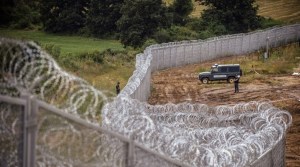US Continues To Install Massive Electronic Spying Network On The US Border


The US border is one of the most crossed international borders in the entire world. People attribute this to many reasons, the most vocally stated of which is that “illegals” are “invading” the US. However, what is also interesting is that the US border has a massive electronic spying network on it that uses super technologies, thermal imaging, and many more developments to spot and monitor people for miles away, including legally residing citizens.
Border Patrol’s electronic eyes will spot you long before you spot them.
If you walk along the United States border in remote stretches of New Mexico desert, or in the grasslands between North Dakota and Canada, you might not hear the buzz of what could be flying above you: A Predator drone — the same vehicle that has been outfitted to drop bombs over Afghanistan and Iraq. From five miles away, the drone’s cameras can see so well they can tell if you’re wearing a backpack.
If you’re in the Florida Keys, you may be spotted by an altogether different set of eyes in the sky. Up 10,000 feet in the air, a football field-sized zeppelin floats with an array of cameras, sensors, and radar systems so sophisticated that it can track every car, aircraft, and boat within a 200-mile range.
And if you’re near the deserts of southern Arizona, it won’t be hard to notice the 160-foot towers that rise up from the sandy landscape, equipped with advanced thermal imaging that can sense your exact movements from over seven miles away.
Because large portions of the border are so remote, and because U.S. citizens seem more willing to endorse surveillance programs that specifically target non-citizens, American borderlands have become a testing ground for cutting-edge surveillance tech.
To call this technology “Orwellian” would be anachronistic. Even George Orwell, for all his dreary imagining, never conceived of an infrared camera that could detect a person’s faintest movements.
Even as privacy hawks on the left and the right warn about the government’s embrace of surveillance tech, it’s been impossible to stop the fast-accelerating development of new infrastructure. President Donald Trump and Democrats in Congress might clash over the need for a border wall, but there’s a growing consensus in Washington that the country needs a “virtual wall.” The terms for this concept vary: House Speaker Nancy Pelosi calls it a “technological wall”; other members of Congress have adopted Silicon Valley lingo and refer to it as a “smart wall.”
Jeffrey Tucker, the editorial director at the libertarian think-tank American Institute for Economic Research, says that people who would otherwise have a knee jerk reaction against federal overreach suddenly acquiesce when the government develops enormous power in the name of border security.
“Look what you’re giving up: All your basic constitutional rights that you would normally fight for get confused when it comes to the immigration issue,” Tucker says. (source)
The US border is not “allowing for an illegal invasion,” and this is proof of it.
If the US wanted to shut the border down and seal it, she could. She has the technology, weapons, manpower, and such a rigorous zeal for “getting things done” that it would be closed if she wanted it. Indeed, if she so had the will, the entire population of over 100 million Mexicans could gather and attempt to rush it, and the US would respond with a hail of artillery fire to murder all of them just as how she set up ISIS, a terrorist group, to commit genocide against the Christians of Iraq for geopolitical expediency and she could care less.
However, the issue here is not even about genocide, but surveillance and rights.
The rights of a people are as only as good as the will to enforce them. In the case of “border security”, the people on both the left and the right have repeatedly supported the sacrifice of personal freedoms in the name of “security”, and every time neither side delivers on anything but demanding the concession of more rights.
This again notes the political nature of border politics, for it is at the border that policies which would later be applied to the citizenry are first tested under the excuse that people who are from “another country” do not have the same rights because they are “foreigners”, something which has been repeatedly stated by many.
Border politics have, for the most part, nothing to do with “illegals,” but about testing that which will be used against the common man in the future who wants something to be done about the border.
If one is willing to sacrifice his freedoms for “security,” who is the guarantor of said security, and if that guarantor is questionable, is it not reasonable to believe that his promises may also be of an equally dubious nature?
It is a cyclical pattern in history that those who ask for protection end up becoming those enslaved by those they asked to protect them. It happened to the Abbasid Caliphate by the Turks, the Poles by the Germans, the Picts by the Anglo-Saxons, and so on, and it is happening again, this time by fellow Americans against each other by corporate and financial interests.
The lessons of history do not exist in a vacuum, nor are there “exceptions” for people because of their background, because principle remains consistent in spite of superficial distinctions.





Comments are closed.